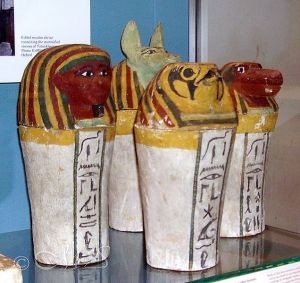Linen played an important role in mummification and the process was diverse, changing throughout the centuries. After the body and its important parts were prepared, it was wrapped with many layers of linen in varying ways. In the early period each limb, finger, and toe was wrapped individually, coated in resin, and moulded in plaster. During the final steps, lifelike colors were painted over the face. As many as 40 layers of linen have been found on some mummies.
The innards were preserved separately and were an important part of the process. Each organ was carefully dried in salt, wrapped in linen, and placed inside canopic jars then finally canopic chests.
These jars are available all over the markets in Egypt today and are a popular tourist commodity. There are 4 designs each representing animal heads which are the 4 sons of Horus, the Hawk headed god of order.

Image Source – Wikipedia – Apepch7
Because the sole purpose of mummification is to preserve the person for eternal afterlife, each canopic jar protects a specific body part. The intestines are protected by the falcon head, the stomach by the jackal, the ape protects the lungs, and the human head the liver.
One thing of note the modern jars found in the markets today are void of any important contents, at least I did not see any.
Other sources: Ancient Egyptians for Dummies by Charlotte Booth
